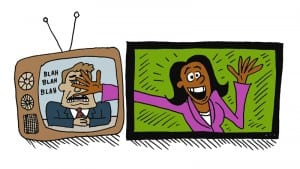 We hear predictions that social media will completely replace traditional broadcast news as the primary channel to reach important audiences. There may be some truth to that. Each day, social media and digital content wiggle their way further into every corner of our lives. Content shared socially can be simple, edgy, immediately accessible, and often deeply personal.
We hear predictions that social media will completely replace traditional broadcast news as the primary channel to reach important audiences. There may be some truth to that. Each day, social media and digital content wiggle their way further into every corner of our lives. Content shared socially can be simple, edgy, immediately accessible, and often deeply personal.
For more than 25 years, I’ve coached thousands of executives on how to prepare for television interviews. Perhaps it would be more accurate to say I’ve “coaxed” executives, because more often than not most are reluctant to face the cameras. And for executives who are not fond of the in-your-face elements of live television interviews, social media provides the perfect cover.
I’ll leave it to others to opine on effective social media strategies, but from my vantage point, television interviews are still one of the most personal and intimate ways to address an audience. It’s the closest you can come to looking your audience in the eye and connecting on both a physical and emotional level.
But, while TV is personal, “personality” is often lost in the translation and executives tend to default to the dreaded “Talking Head.” The Talking Head is the drone of TV news – scripted, drooling jargon, rigid, unintelligible and devoid of emotion. So, let’s put the Talking Head to bed for good. It’s a turnoff for an audience and a self-inflicted wound for the executive.
In its place, make way for the 21st century storyteller we’ll call, “The Expressive.” The Expressive earns credibility for the story, and the audience’s admiration by speaking simply and eloquently. The Expressive looks beyond the hardware of the camera to seek a personal connection and to speak directly to hundreds of thousand individuals, one-on-one. The Expressive is never daunted by the camera, and could just as easily be conversing on the factory floor, in the boardroom, or across the backyard fence. The Expressive doesn’t fear going off script, because he or she is deeply connected to the story (click to tweet).
Here are five touchstones that can jump start a transformation from Talking Head to Expressive and earn credibility in a broadcast interview.
1. Have a Great Opener: The first words out of your mouth should be bold and imaginative and invite the audience to dive into your story. Compelling is good. Routine is not good. And forget about using your open as a warm up. You’ve got a matter of seconds before the audience decides if they want to listen, so plan a great opener, and make it worth the audience’s time.
2. Make it Relevant: Certainly, you care about your story, but why should the audience care? The easiest way to stay in “Talking Head” land is to talk to yourself. Think about why it matters to the audience, and let them know why it makes a difference for them.
3. Simplify: Edit your words and strike out all jargon. This can take a few rounds in rehearsal, as most of us tend to quickly default to company shorthand. But, how many times can you use the word “innovative” in a single interview? Make sure the words you use are simple, clear phrases that anyone can quickly understand.
4. Smile Big and Eyes Bright: Use your physical attributes. Smiling increases the energy projected from your face, and inspires smiles in return. So much of a story and a storyteller’s personality is conveyed through the eyes. If your eyes are focused, bright and lively, it signals you are deeply invested in what you have to say. Wandering eyes suggest that you may be searching for answers, or worse, deceitful.
5. Get Comfortable Sharing: TV interviews used to be about the company line. Now, they’re about what you as a leader really think and feel. Bring yourself into the story, and share your personal viewpoint. A successful Expressive is invested in the story and is a critical character in the overall narrative.



